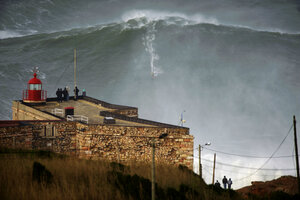A 62-foot wave was recorded in the North Atlantic. How'd they measure it?
Wave monitoring is part of international efforts for the purposes of maritime interests and science.

US surfer Garrett McNamara rides a wave off Praia do Norte beach in Nazare, Portugal, on Jan. 28, 2013.
To Mane/Nazare Qualifica/AP/File
Somewhere in the North Atlantic Ocean in 2013, a wave-recording buoy floated higher than a buoy has ever floated before.
The World Meteorological Organization announced on Tuesday a new world record for “significant wave height” as measured by a buoy, after a sensor climbed to 62.3 feet in a stretch of ocean between Iceland and the United Kingdom.
That tops the previous record of 59.96 feet, set in 2007, also in the North Atlantic.
“This is the first time we have ever measured a wave of 19 meters. It is a remarkable record,” said Wenjian Zhang, assistant secretary general at the WMO, in a statement.
It’s the latest oddity to make the archive of extreme-weather events kept by the agency, along with a 2-pound hailstone that thudded down over Bangladesh in 1986 and the 1.25 inches of rain that fell in a single minute in Maryland in 1956, notes Arizona State University’s School of Geographical Sciences and Urban Planning.
The present record may underscore the value of international efforts – like buoys that record data on ocean swells, currents and temperatures – that benefit climate research, marine science, and the shipping industry.
“It highlights the importance of meteorological and ocean observations and forecasts to ensure the safety of the global maritime industry and to protect the lives of crew and passengers on busy shipping lanes,” said Dr. Zhang.
“We need high quality and extensive ocean records to help in our understanding of weather/ocean interactions,” he added. “Despite the huge strides in satellite technology, the sustained observations and data records from moored and drifting buoys and ships still play a major role in this respect.”
The North Atlantic is famed for its harsh weather: wind circulation patterns and atmospheric pressure during wintertime often create intense extra-tropical storms, meaning that the region from the Grand Banks plateaus off of Canada’s Newfoundland up to the south of Iceland and off Britain's west coast produce most of the world's wave records, according to the WMO.
The latest wave isn’t exactly the biggest wave ever: as the BBC noted in 2014, there’s a difference between measurements taken from ships (where one wave in the North Atlantic topped 95 feet in 2002), video footage (as big surf waves are usually analyzed), and wave-riding buoys.
“[Wave-riding buoys] don't aspire to measure individual waves, they aspire to take a sensible average of three-wave parcels,” said Dr. Kevin Horsburgh, head of marine physics and ocean climate at the National Oceanography Centre (NOC), in a 2014 interview.
“If you use different-sized buoys you actually get different readings, so it's a very ongoing area of research to find the most reliable and consistent wave measurement,” he said then.

